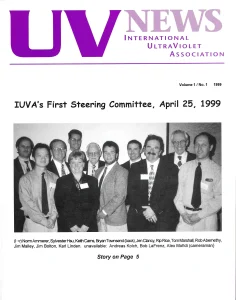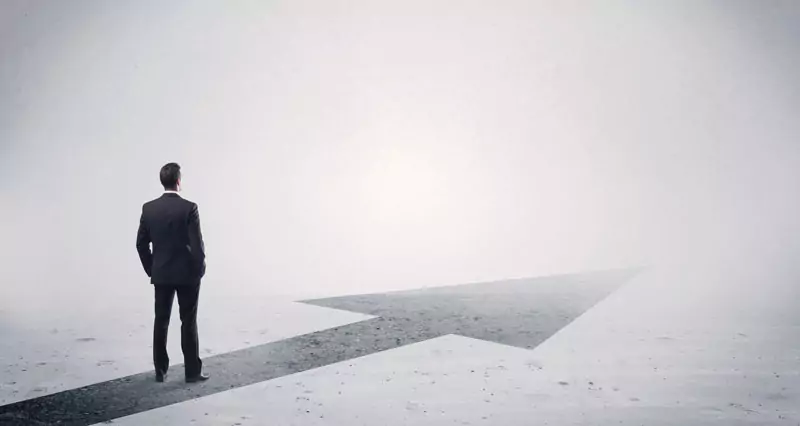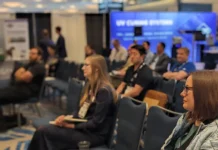Professor James P. Malley
editor-in-chief, UV Solutions
It seems like a short time ago that Jim Bolton and the late Rip G. Rice asked me to lead an effort to organize the International Ultra Violet Association (IUVA). Prior to that, my career revolved around being a water/process teacher, researcher and consultant. I had been extremely fortunate to receive support from WateRF in 1994 to study UV technologies for drinking water, and, at a retirement symposium for EPA legend Professor Jim Symons, Assistant Professor Karl Linden labeled me an “island for UV in drinking water.” It has been a pleasure to see him and many of his excellent students and other colleagues grow that “island” and lead that and other research areas.
In the beginning

The timing of IUVA formation was catalyzed by a very important finding from Jim Bolton, Jennifer Clancy, Bertrand Dussert and Marilyn Marshall, along with the many talented engineers, scientists, staff and students in their respective supporting organizations. In 1998 their WateRF-, EPRI- and EPA-funded research showed UV disinfection could cost-effectively inactivate Cryptosporidium. Dussert recalled: “When Sam Stevens and I received the call from Marilyn’s lab that the mice who had been given water spiked with a high number of Cryptosporidium oocysts (10x) but irradiated by low doses of UV (10 to 20 mJ/cm2) were ‘alive and well.’ Stevens and I were very loud in expressing our joy, while nearby offices were wondering what was wrong with the Canadian and the Frenchman.”
Longtime IUVA Executive Director Jim Bolton played a seminal role in this critical research by providing the UV collimated beam equipment, training the microbiological researchers on its proper use and serving as project manager for the original funding sponsor of the research, Calgon Carbon Corporation. He recalled, “The presentation at the 1998 Annual Conference of the American Water Works Association was the discovery moment where, for the first time, it was revealed publicly that low UV doses were effective for inactivating Cryptosporidium. Although I presented the ‘discovery’ paper, the participating members – Bolton, Bukhari, Clancy, Dussert, Hargy, Marshall and Stevens – of the research team worked very closely together. All deserve equal credit for the discovery.”
This important finding, coupled with the political pressures and economic realities of the ongoing EPA rulemaking – LT2ESWTR and Stage 2 D/DBPR – in the wake of the Milwaukee Crypto outbreak in 1993, led to the EPA pulling together an expert workshop. Following that meeting, 22 professionals formed a steering committee that led to the formation of IUVA, which was incorporated in 1999.
Advancing UV technology
Originally, my vision was for “a broad-based, multidisciplinary association of professionals from around the world who share common interests in advancing the scientific and engineering understanding of UV light and technology. UV light is studied and applied by a diverse array of professionals from atmospheric chemists who are concerned with ozone layer depletion and global warming to environmental scientists and engineers concerned with hazardous waste treatment and/or the disinfection of wastewater, drinking water and water for reuse.
“One can find tremendous knowledge and expertise related to UV light and UV technologies spread throughout the world in UV equipment manufacturing firms, universities’ consulting firms, research institutes and regulatory agencies. Yet these groups have never had a dedicated forum through which to share ideas and plan collaborative projects.”
So how have we done? Executive Director Gary Cohen received the following feedback from members affirming the association has:
- Provided a platform for recognition of students, researchers, manufacturers and designers by presenting international conferences and providing awards to the best in UV technology.
- Played key roles in research that determined UV was effective for Giardia and Cryptosporidium inactivation, as well as in other areas such as:
- USEPA UVDGM;
- standardized UV collimated beam methods;
- developed standard protocols for lamp testing;
- developed validation protocols for UV equipment;
- advanced understanding of UV validation to include action spectra correction factors, testing with low wavelength sensors and validation of higher UV doses with multiple organisms to ensure compliance with the requirements for 4 log virus inactivation;
- development of advanced oxidation processes, such as UV/hydrogen peroxide;
- UV technology advancements including UV LEDs and UV/chlorine research;
- spread UV research findings to all stakeholders;
- formed a task force to address issues related to an organism’s action spectra and ensure validated systems were conservatively protecting public health; and
- developed focus groups and expanded UV technology understanding, design and applications into the areas of food and beverage, as well as health applications.
Former president and recognized UV research leader Karl Linden shared, “I credit the formation of IUVA as being the single most important factor enabling the many rapid successes UV science and technology has seen over the past 20 years. It is this community of UV nerds that had a regular chance to debate and challenge each other, compete with and ultimately make each other better, and be successful in our respective careers. Otherwise we would have been operating in our silos – industry, academics, utilities, consultants, regulators – and never had a consistent year-to-year opportunity to cross-pollinate and create the ripe environment that led to the advances that have been made across the UV community. And we have had a lot of fun together on the way.”
Networking and career development, as well as moving the entire industry forward, were further echoed by former President Paul Swaim. “Year after year I had the opportunity to present in front of my peers in the field of disinfection. One evening in Paris at the May 2011 World Congress, a dozen or so of us rode across town on the Metro after the day’s session to discuss and debate the action spectra correction issue. After a few hours, we decided that it was an issue that required a task force to address.”
Exploring new horizons
Innovations and full-scale applications of UV technology include the development of new, more efficient and sustainable lamp sources. There is UV industry-wide excitement in the advancements made in UV light emitting diodes (UV LEDs). UV LEDs are a major focus of current research, publications and conferences, with applications being explored in drinking water, foods, beverages, personal home healthcare devices and industrial/military applications. Additionally, researchers have improved the overall energy efficiency of traditional UV sources and have developed methods to more efficiently monitor low UV wavelengths for polychromatic UV systems.
Research also continues to advance the understanding of UV-related advanced oxidation processes that are in common use for water reuse and remediation of contaminated sites. All these efforts are aimed at reducing the costs and environmental impacts – especially carbon footprint – of UV technologies. UV researchers have developed and refined validation protocols for UV lamps, sensors and overall UV system performance. These efforts have led to optimized UV doses to obtain disinfection credits for Giardia and Cryptosporidium, which helps many utilities with simultaneous compliance of the LT2ESWTR and the Stage 2 D/DBPR.
Developments of additional microbial surrogates, further understanding of UV system mathematical modelling and UV sensor improvements have allowed validation of UV systems for 4 log virus inactivation credit to assist utilities with GWDR compliance. UV researchers also have demonstrated in many small systems the combination of UV disinfection and chlorine/chloramines of varying contact times can solve historical problems with simultaneous compliance with multiple regulations.
UV technology researchers also address fundamental research questions such as the disinfection mechanisms involved in adenovirus inactivation, potential for unwanted DBPs or toxicity from UV technologies and the chemical kinetics and degradation by-products of treating organic micropollutants with UV-H2O2 and UV/chlorine in the presence or absence of nitrogen compounds and nitrate.
UV technologies also have received extensive research, interest and full-scale applications in groundwater remediation and to address emerging organic micropollutants (from 1,4-dioxane to PFCs) in drinking water, wastewater and water reuse. One example of this is the cost-effective removal of NDMA by direct UV photolysis. Furthermore, the combination of higher UV doses with hydrogen peroxide addition – yielding an advanced oxidation process that employs hydroxyl radicals to treat a wide array of organic compounds – has been used worldwide. More recently, research has been conducted into full-scale applications of radical oxidation generated by increased UV doses in the presence of free chlorine. The UV-chlorine advanced oxidation process has been explored in water reuse as a lower-cost option that also avoids issues associated with hydrogen peroxide while taking advantage of widely used and often on-site chlorine.
Moving forward
UV technology applications transcend the water industry, moving to serve the broad applications in the food and beverage industry, the medical and dental professions, and in the treatment of air and solid surfaces. There have been significant research developments and applications in the use of UV technologies for bottled water, dairy, grains, food safety, surgical instruments and hospital surgical suites. The future of UV technologies is bright.
During the preparation of this article celebrating IUVA’s 20th anniversary, many individuals were contacted for their thoughts, memories and comments. Some, of course, could not be reached, and it would be impossible to name, acknowledge and thank all of the professionals who have been so vital to IUVA and to the UV technology field, but I would like to close by thanking by name each of the IUVA presidents and executive directors not quoted previously: presidents – Jennifer Clancy, Andreas Kolch, Linda Gowman, Bob Hulsey and Katherine Bell; executive directors – Paul Overbeck, Deborah Martinez and Gary Cohen. Longtime IUVA Administrative Assistant Kathy Harvey served as a vital cog in all of our logistical success during those early years. Finally, thank you to all current IUVA staff who support Gary Cohen on a daily basis and to the folks at Peterson Publications responsible for the publication of UV Solutions.
Contact Jim Malley at editorinchief@iuva.org.






